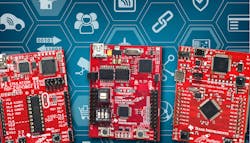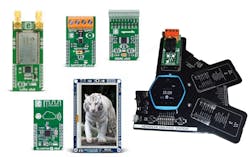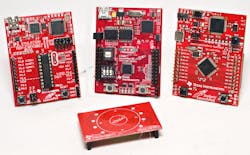In many cases, when developing solutions for the Internet of Things (IoT), engineers will try out new sensors, communication links, and control subsystems. Lots of developers choose platforms like Raspberry Pi, BeagleBone, or Arduino because of the plethora of expansion options offered by their communities. And many vendors choose these form factors to provide development boards to deliver services like neural networks in their processor chips.
A number of smaller expansion form factors maintain a wide variety of peripheral options. Variety and ease of design is important because it often provides a way to gain access to the latest technology. There are platforms like Mini-PCI Express, but these tend to be more expensive and designed for deployment.
1. MikroElektronika’s ClickBoards are used on platforms like NXP Hexiwear, which has three sockets.
MikroElektronika’s ClickBoard family (Fig. 1) includes everything from Bluetooth and GPS to Hall-effect and multi-axis sensors. A variety of display options is available, too, some with touch support. These boards can be used on IoT development platforms like NXPs’ Hexiwear. The Hexiwear module can be removed and placed into a wristband, but it would have to leave the expansion modules behind. On the other hand, a custom design could incorporate the base and expansion board functionality into a wearable prototype.
Some vendors have developed their own form factor with a number of expansion options. For example, Texas Instruments’ (TI) BoosterPack modules are designed for the firm’s Launchpad series of development boards (Fig. 2). Many of these modules are used to highlight TI’s solutions from wireless communication to wireless charging. BoosterPacks can be stackable, which isn’t possible with ClickBoards.
2. Texas Instruments’ BoosterPack modules are designed for its Launchpad series of development boards.
Vendor-specific platforms can sometimes garner third-party support if the development boards are popular enough or if they partner up with the vendor. One way to get access to other expansion boards is via an adapter board (Fig. 3). For example, MikroElektronika’s USB adapter links a USB host to a Clickboard using USB serial ports. The RobotShop’s XBee Shield for Arduino has access to the range of third-party XBee modules.
3. The Clickboard USB adapter (left) provides expansion board access to any USB host, while the Arduino XBee adapter (right) stacks on top of an Arduino-compatible host.
Clickboard, XBee, and BoosterPack modules represent just a few of the options available to developers. Most of the interfaces on these compact modules are serial interfaces like SPI or I2C, or parallel ports. The module designs are typically available as open-source designs, allowing for easy integration into a custom platform.
Developers working with many of these platforms may want to check out Gumstix Geppetto. It’s a web-based board design tool that can deliver finished boards within weeks. It has templates for Raspberry Pi and BeagleBone connections. I’ve written about Geppetto in the past, and it has improved significantly since that time.
Trying to decide what peripherals are important to a design is sometimes easy, but the device that works best may require more evaluation. Using a modular approach makes it possible to test different solutions.
About the Author
William G. Wong
Senior Content Director - Electronic Design and Microwaves & RF
I am Editor of Electronic Design focusing on embedded, software, and systems. As Senior Content Director, I also manage Microwaves & RF and I work with a great team of editors to provide engineers, programmers, developers and technical managers with interesting and useful articles and videos on a regular basis. Check out our free newsletters to see the latest content.
You can send press releases for new products for possible coverage on the website. I am also interested in receiving contributed articles for publishing on our website. Use our template and send to me along with a signed release form.
Check out my blog, AltEmbedded on Electronic Design, as well as his latest articles on this site that are listed below.
You can visit my social media via these links:
- AltEmbedded on Electronic Design
- Bill Wong on Facebook
- @AltEmbedded on Twitter
- Bill Wong on LinkedIn
I earned a Bachelor of Electrical Engineering at the Georgia Institute of Technology and a Masters in Computer Science from Rutgers University. I still do a bit of programming using everything from C and C++ to Rust and Ada/SPARK. I do a bit of PHP programming for Drupal websites. I have posted a few Drupal modules.
I still get a hand on software and electronic hardware. Some of this can be found on our Kit Close-Up video series. You can also see me on many of our TechXchange Talk videos. I am interested in a range of projects from robotics to artificial intelligence.





